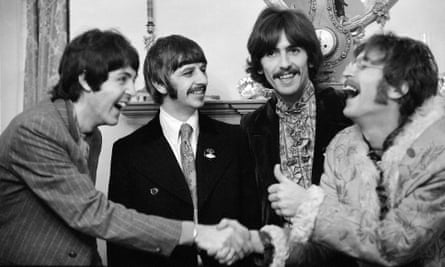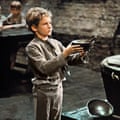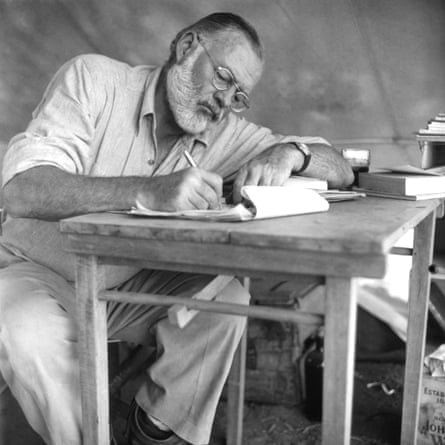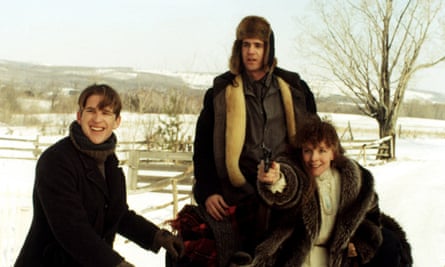The Beatles
I am the youngest of seven, so I got a steady diet of the Beatles from my brothers and sisters at a young age. The Beatles first came to the United States in 1964 when I was four. It’s remarkable how much these boys with the skinny ties changed the world by the time they released Sgt Pepper’s Lonely Hearts Club Band in 1967.
I loved the political aspects of John Lennon, the intrigue and impact of Yoko Ono and whether she was really responsible for breaking up the band. Their “bed-ins for peace” sit-in was so provocative. Every Christmas they still put up a billboard in Times Square that says: “War is over! If you want it.” The important part of that statement is: if you want it. I have always felt that human beings have such a terrible love of war that they don’t seem to want to find peaceful solutions. When you think about it, almost every Beatles song is about peace and love.

Midnight Cowboy at the drive-in next door
I was born in Loma Linda, California. My father was a drive-in theatre manager, so we moved around a lot. We moved to Imperial Beach then Utah when he became general manager of a half-dozen drive-in theatres. Utah has all the influences of the Mormon church. Listening to the Beatles in Utah would have been tantamount to listening to devil music.
The houses we lived in were adjacent to the drive-in so I could watch the movies right from the porch. During the summer, I was at the drive-in all the time. Cars would park between two speakers on a pole and I’d just watch the movie sitting on the ground between the speakers.
If Midnight Cowboy came out today, it would probably be a PG13. It’s not really shocking at all. In 1969, it was X-rated. Normally an X-rated film would be playing at a little low-rent theatre in some seedy part of town. At my father’s drive-in, people could accidentally see something risque or obscene as they drove by and so the church got very upset and angry.
Oliver!

In those days, the film companies would send these 16mm movie trailers to the drive-in theatre managers to try to sell their movies. They would also send these making-of movies. I remember seeing the making of Oliver! with Mark Lester. It was the first time that I saw children acting as a profession; you could see them taking singing and dancing lessons. And so I thought: “Well, that’s what I want to do.”
We were living in Orem, Utah, and there was a tap-dancing school in Provo, just down the road. My father got me this beautiful pair of patent leather tap-dance shoes but he couldn’t afford to send me every week on his drive-through wages, so I got a book and a record and learned how to tap dance: step, heel, toe, ball, step, change, turn. Maybe once a month, I went to class to try to keep up with the other kids. Then I joined the glee club in junior high school, and amateur theatricals and productions through high school.
The Man Who Would Be King
I had seen Sean Connery singing and dancing in Darby O’Gill and the Little People. Then of course I saw him in James Bond. But it wasn’t until I saw him in The Man Who Would Be King and Outland that I started to understand that Sean Connery wasn’t really a spy or an astronaut; and that acting was a profession and this was a profession that I wanted to follow in.
I met Sean Connery in New York City. Connery co-founded the Friends of Scotland charity in 2002 and every year they hold this charity fashion dinner called Dressed to Kilt. Over dinner, I told him about seeing him in all these different movies and how special it was meeting my childhood icon now I was a grownup. He was such a gentleman; he was so kind. He told me that after I had done Birdy in 1984 with Nicolas Cage, he had called [Bugsy Malone and Birdy director] Sir Alan Parker and said that he wished he could act like Modine. You could never imagine Sean Connery playing a character like Birdy, but he had enough of an appreciation of the sensitivity of the role that he wished that he could play a character like that.
The Old Man and the Sea

Ernest Hemingway’s novel The Old Man and the Sea had a tremendous impact on me because it’s about this one individual, the old man going out on the sea. I loved the ocean as a boy. I was a surfer, and the language that Hemingway uses is so evocative. It is so sensual that you can almost taste the little sardines and flying fish. You can picture the old man’s struggle to land the giant marlin as he holds on to it at the end of his fishing line for two days. When the shark devours the marlin, you can sympathise with the old man that he won’t be able to bring it home to feed so many people.
Like it or not, we all have to go through things like this in life. We go through life with the assistance and help of others, but we go to sleep and we wake up by ourselves. The Old Man and the Sea is a great book about self-reliance and it is so beautifully told. It’s like Billy Joel says in You’re Only Human: “You’re allowed to make your share of mistakes / You better believe there will be times in your life when you’ll be feeling like a stumbling fool”.
The cold war
We were taught the American civil war at school but glossed over the first world war. When we got to the second world war, we skipped the European history and were taught that it was the great hero America who saved the world from the Nazis with the atomic bomb.
When I did Mrs Soffel with Diane Keaton and Mel Gibson in 1984, I was invited to the Berlin film festival. I said: “I can’t go to East Berlin, I’m American.” They said: “No, you can go to East Berlin because you’re an American.”

Checkpoint Charlie was the opposite of The Wizard of Oz; it seemed to go from colour into black-and-white. There were still broken bits of concrete; it felt like the buildings were still on fire. They took me to the Soviet war memorial for 80,000 Soviet troops who had lost their lives taking Berlin. I met these Russian soldiers and gave them American cigarettes and they gave me pins from their uniforms. Back in Reagan’s America, it was still the cold war, and Russia was the enemy of choice for every movie and television show, and I just didn’t want to part of perpetuating that lie. So that’s why I turned down the Tom Cruise role in Top Gun. I did Full Metal Jacket, which was much better!

Comments (…)
Sign in or create your Guardian account to join the discussion